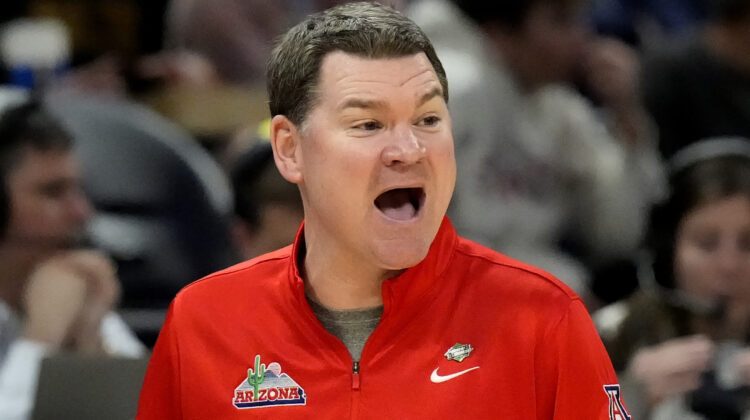The Hotline mailbag publishes weekly. Send questions to pac12hotline@bayareanewsgroup.
Please note: Some questions have been edited for clarity and brevity.
The transfer portal has closed and coaching changes are slowing down. How do you think the ‘Four Corners’ schools will do in their inaugural season in the Big 12? — @vakaviti
In totality, not very well. Arizona should manage the experience successfully, but the other three schools are facing difficult situations.
The Big 12 is arguably the toughest conference in the country. It claims two of the past four national champions and had eight bids to the NCAA Tournament last season.
Yes, there was speculation the conference gamed the NET rankings to bolster the metrics, and it didn’t perform to expectations once the event began. But nobody would dispute the notion that the Big 12 regular season is a first-class meat grinder that will punish the weak and vulnerable.
From here, Arizona State, Utah and Colorado look weak and vulnerable.
The Sun Devils will have a new roster. Granted, it’s a better roster than anyone had the right to expect thanks to a commitment from five-star big man Jayden Quaintance. But the Devils don’t possess the depth needed to navigate the Big 12 successfully.
Colorado has been walloped by attrition, with Tristan da Silva, Cody Williams and KJ Simpson entering the NBA. The retooled rotation won’t be nearly as talented.
Meanwhile, Utah is scrambling to find traction under fourth-year coach Craig Smith, who just lost assistant Chris Burgess and big man Keba Keita to Brigham Young.
Every flaw will be exposed in the Big 12, especially the lack of depth. Combine the long season, arduous travel and the number of quality teams in the conference and, in our view, rotations must be eight or nine deep with players capable of starting.
We don’t see that quantity of quality on any of the three rosters.
With Arizona entering the Big 12, two things are equally true: The Wildcats won’t have nearly as much success as they did in the Pac-12, and they are far better positioned than the other Four Corners schools.
Coach Tommy Lloyd lost a slew of top-tier players, including guard Caleb Love and big man Oumar Ballo, but has reloaded the roster. Guard Trey Townsend, who averaged 17.3 points for Oakland, is exactly the type of player needed to keep the program from backsliding significantly in its new home.
The Wildcats finished first or second in the Pac-12 for three consecutive years under Lloyd. We don’t expect them to match that level in a conference with Kansas, Baylor and Houston.
What’s reasonable for Arizona? Placing in the top five regularly and the top two every few years.
What’s the Over/Under that ‘Calimony’ is approved at the recommended amount of $10 million per year? — @AJ_HM
I’m not sure that’s the right way to view the situation.
We could offer an Over/Under on the expected “contribution” amount, or a percentage on the likelihood that the UC regents follow through with the $10 million proposal.
It seems unlikely that Michael Drake, president of the University of California, would place $10 million (the maximum allowed) on the agenda for the May 14 meeting (at UC Merced) if he weren’t confident in the support.
But with the regents, nothing is ever certain until the votes are tallied.
Could they drop the subsidy to $7.5 million, for example? Perhaps. But it’s not going to $2 million (the minimum). And whatever the final number, it will have a material impact on UCLA’s competitive success.
Will Fox force the Big Ten Network into the lowest common cable and satellite packages this fall in the media footprints of Washington, Oregon and USC/UCLA? That way fans don’t have to pay more to get it. — @tobsandmags
Fox didn’t orchestrate the addition of UCLA, USC, Oregon and Washington to price the Big Ten Network (BTN) at out-of-market subscriber rates up and down the heavily populated West Coast.
Quite the opposite, in fact. The BTN assuredly will be shown on expanded basic cable tiers across the various cable and satellite systems, allowing for vastly higher subscriber price.
When Rutgers joined the Big Ten back in 2014, the BTN moved to an expanded basic tier for the cable systems in New York City. Expect the same in L.A., Portland and Seattle
On a 1-to-10 scale, what are the chances that USC has a better conference record than Oregon next year? The Ducks are the only team in the Big Ten to play eight consecutive conference games without a bye. — @Ddwag367744
Less than 50-50, for sure. So let’s say the likelihood is 3 or 4 on your scale.
Oregon’s conference schedule is difficult: eight consecutive weeks without a bye, Ohio State at home and Michigan on the road.
USC’s schedule includes a trip to Michigan and a home date with Penn State. But the Trojans open the season against LSU in Las Vegas, which figures to be a taxing game (physically and emotionally).
But the primary difference in our outlook for the two teams is rooted in the rosters. The Ducks have more playmakers, more quality depth, more talent on the lines of scrimmage and the better quarterback (Dillon Gabriel over Miller Moss).
We see Oregon as the primary challenger to Ohio State for the conference championship, while the Trojans fit somewhere on the second tier.
Until Lincoln Riley and Co. produce a defense capable of limiting opponents to 25 or 30 points, we have no reason to view them as a title contender.
Do Stanford and Cal have escape clauses should they want to leave the ACC? — @MrEd315
They do not, to the extent that we are aware. The schools signed a membership agreement with the ACC through the 2035-36 academic year, which coincides with the duration of the conference’s grant-of-rights agreement.
That said, the worst-case scenario for the Cardinal and Bears — getting stuck in a depleted conference — is also the least likely of three possible scenarios:
— The ACC stays intact through 2036.
— The ACC implodes in the next two or three years as a result of the lawsuits brought by Clemson and Florida State.
— Clemson, Florida State and North Carolina leave the conference for the SEC and/or Big Ten, but the grant-of-rights agreement holds for the other 14 football members, leaving Cal and Stanford legally bound to the ACC through 2036.
In our view, there will be no middle ground. If one school leaves, the whole thing ruptures.
Does the Big 12 have its own network? How will football games be broadcast that aren’t picked up by Fox/ESPN? — @tomrwhitney
There is no equivalent of the SEC Network or Big Ten Network.
Big 12 schools used to control their Tier 3 rights and sell them locally — an arrangement that flowed from the creation of the Longhorn Network for Texas.
Not anymore. ESPN now owns those rights.
Any Big 12 games not shown by the Fox and ESPN linear networks (Fox, FS1, ABC, ESPN, etc.) are shown on ESPN+, the network’s digital platform.
The campuses produce those events for ESPN+, which means they need the technological infrastructure.
The Four Corners schools are currently building out their facilities.
How screwed up is Brigham Young football for the next three or four years? — @utahfootballgm
We don’t see the Cougars making much impact on the Big 12 race. Certainly, they aren’t nearly as well equipped to succeed as Utah.
The Utes are the team to beat in the fall, in our estimation.
BYU lost immense competitive ground during its tenure as an Independent and needs years to catch up.
What’s your drink of choice for drowning my sorrows when the 10 departing schools play their first conference games next season? — @tmmmurph
The Hotline drinks coffee in the morning, Diet Coke in the afternoon/evening and water at all times, so we cannot offer a recommendation involving alcohol.
The last time we had an adult beverage, Utah was in the Mountain West.
But you aren’t alone in that sentiment — many fans of the outbound schools would have preferred a different outcome.
Heck, the administrators at the outbound schools would have preferred a different outcome, which is why they stuck around for 13 months before the whole thing shattered.
A flourishing Pac-12 with at least 12 schools and revenue streams similar to the ACC and Big 12 would have been better for everyone, especially the athletes.
But a series of strategic mistakes and management missteps led to the implosion.
Only an expert level of incompetence, played out over many years, can kill a 108-year-old college sports institution.
The Pac-12 cornered the market on incompetence.
*** Send suggestions, comments and tips (confidentiality guaranteed) to pac12hotline@bayareanewsgroup.
*** Follow me on Twitter/X: @WilnerHotline
*** Pac-12 Hotline is not endorsed or sponsored by the Pac-12 Conference, and the views expressed herein do not necessarily reflect the views of the Conference.
Related posts:
 Hotline mailbag – On the “big bias” with ESPN, the Pac-12’s low bid total, Kriisa’s injury, Fox and Haase remain in place and more
Hotline mailbag – On the “big bias” with ESPN, the Pac-12’s low bid total, Kriisa’s injury, Fox and Haase remain in place and more

Washington State quarterback Cameron Ward (1) (AP Photo/Young Kwak)
Heisman Watch: Penix on top, Ward and Nix rise
Oregon running back Bucky Irving, (AP Photo/Amanda Loman)
Pac-12 bowl projections: Oregon to the playoff, Washington State to Las Vegas, Arizona drops out
(AP Photo/Rick Scuteri)
College basketball 2023-24: The Hotline’s preseason top-25 rankings, 4 Pac-12 schools make it
